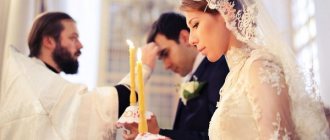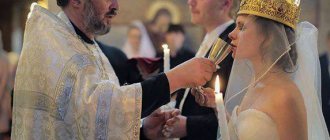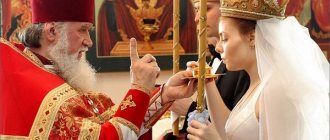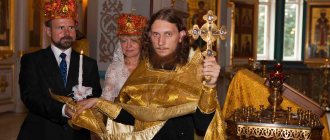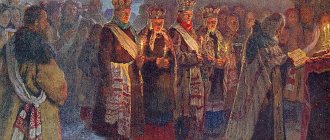Wedding in Moscow
A wedding in one of the Moscow churches - the bride and groom are ready to enter into an alliance before the Lord and walk through life hand in hand. Wedding candles burn in the hands of the newlyweds, the priest reads prayers, conducts the betrothal ceremony and places church crowns on the heads of the girl and the guy. The guests watch the ceremony with reverence and in their hearts wish the newlyweds happiness, peace and harmony. This shooting can hardly be called a video clip or video, but this does not make it any less beautiful; on the contrary, the bright sacrament taking place in the Moscow temple leaves an indelible impression.
How to choose the best days for a wedding?
choose the wedding date according to the calendar
As noted above, a church or temple has its own daily routine, in which there are days only for prayers and divine services of monks. For example, during fasting, great holidays known in the world, the wedding ceremony is not held.
Each temple has its own schedule for the whole year in advance. You can get acquainted with it when you come to the priest to agree on a date.
An approximate wedding calendar for 2021 is presented here, and for 2021 - here.
Wedding in Almazovo
The most significant part of the wedding, of course, has always been the Sacrament of Wedding. This is truly an extremely beautiful and solemn Sacrament, preserved to this day. In it, the family is created as a single spiritual organism in a grace-filled union, fulfilling what was ordained by the Almighty through the Bible: “A man will leave his father and mother and cleave to his wife...”.
At the wedding, the bride and groom are given royal crowns as symbols of coronation. At this time, he and she commemorate the first people Adam and Eve, who themselves were the crowns of creation. Crowns also symbolize martyrdom and remind those getting married that family life is not about using each other, but about a difficult voluntary feat of mutual assistance and keeping the vows pronounced at the Sacrament. Video filming of the wedding of Anna and Alexei in the Church of St. Sergius of Radonezh in the village of Almazovo.
What kind of wedding rings are needed?

wedding rings in a box
- More than 10 centuries ago, the tradition of betrothal on the eve of the wedding developed. Both of these sacraments were performed only before the face of God in church
- Closer to our time, registration of marriage in the registry office began to be considered betrothal. Some couples believe that this act is enough to create a new family, while others do not. They either, under the influence of fashion, pressure from parents, personal mutual desire, come to church to get married
- According to church canons, wedding rings are different from engagement rings. The second is a symbol of the desire to reunite in the union of two people. Externally, they can be anything, including expensive options with precious stones
- Wedding rings are more modest and simple jewelry. On their inner side, our ancestors carved prayers, and we carved the wedding date and the name of the spouse
- Correctly chosen rings - gold for the husband, silver for the wife. The first personifies Jesus Christ and Divine power, the second - the Church, purity, loving service
Wedding in Balashikha
The wedding of Elena and Alexei in the Church of the Transfiguration of the Lord in Balashikha. The Church of the Transfiguration of the Lord was created at the end of the 17th century. In 1933 it was closed and looted. But on August 4, 1996, Metropolitan Juvenaly of Krutitsky and Kolomna performed the rite of the Great Consecration of the revived temple in honor of the Transfiguration of the Lord. And today, everyone can venerate the holy icons of the temple and perform the Sacrament of wedding.
The wedding begins with the betrothal of the newlyweds in the vestibule of the temple. The entire wedding video is presented with original sound and you can hear the words of prayers read by the priest and the church chants of the parish choir. Having become engaged, the bride and groom go to the center of the temple, where the Sacrament of the wedding itself takes place. Guests and witnesses mentally support the newlyweds and joyfully congratulate the newly-made couple on entering into a church marriage.
Wedding is the spiritual foundation of the family (+VIDEO)
Why is it necessary to get married? What is the symbolism of rings and crowns? Why do the bride and groom face east during the wedding? What does the expression “love as yourself” mean? How to correctly understand the words: “Let the wife fear her husband”?
Hello, dear friends. The series of conversations “Grammar of Family Life” continues, and today we will talk about the spiritual life of the family and the beginning of this spiritual life, which is the Sacrament of Wedding.
The sacrament of wedding can be compared to baptism - to the baptism of a new family. Here a child is born: having received life from his parents, having received an immortal soul from God, he comes into this world - but the child must be spiritualized, he must be dedicated to God - sanctified in the Sacrament of Baptism. So is family. Creating a family is always a mystery: two completely different people become one, but this union needs sanctification - in the Sacrament of Wedding.
I have in my hands the Trebnik - a book containing the rites of those church Sacraments that are performed in the parish: this is just the Sacrament of wedding, but also the Sacraments of baptism, consecration of oil, etc. Today, even after reading something from it to you, I will tell you about betrothal and wedding
About the importance of wedding
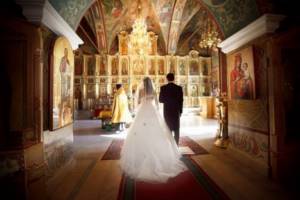
Is it necessary to get married? Yes, marriage must be sanctified. And many couples come to the temple with doubts: “We are not ready for the wedding yet. Maybe we’ll think about it, but for now let’s go to church...” For church people, believers, the question is: is it necessary to get married? – can’t stand at all. If a child is born, he must be baptized; if a young union is created, it needs to be spiritualized and dedicated to God.
God doesn't save us without us. And the Sacrament of Wedding is not some kind of magical act that guarantees a strong marriage
You need to start your family life by asking God for help. We begin any good deed with prayer: we serve a prayer service before traveling, building a house, etc. And, naturally, before building our family hearth, we need to strictly pray to God, and the Lord will grant His grace. But God does not save us without us. And the Sacrament of Wedding is not some kind of magical act that will bind a couple for life, regardless of the spiritual state of the spouses, their faith, and then everything will go for them as if on a well-trodden path, along well-laid rails. Of course, any sacrament and even any ritual, for example, such as the consecration of a car, does not work without a person’s faith: if a person believes that the priest should do everything for him, he himself does not make any effort, does not pray, does not intend to follow the rules of the road, it is clear that this will not help him at all. In marriage it is exactly the same: spouses must lead a spiritual Christian life, must pray for each other, must be Orthodox Christians and must, naturally, themselves call on the power of God for help and believe in the power of the perfect Sacrament, in the fact that the Lord will help them.
Engagement
The sacrament of wedding begins with betrothal. Betrothal is a kind of rite, not even a Sacrament, in which the spouses exchange rings. By the way, betrothal in ancient times, in the first centuries, was not a Christian rite: it accompanied the legal registration of marriage. This is how today in Russia, where the Church is separated from the state, the sacrament of wedding is performed separately from the registration of marriage, and this registration is carried out through registration in the registry office, the same situation was in the Roman Empire. Any marriage that was blessed and crowned by the bishop, and later by the presbyters, had to undergo legal registration. So there are two components in the Sacrament of Marriage: one is legal, the other is spiritual.
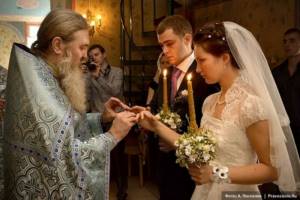
Wedding. Photo: A. Pospelov / Pravoslavie.Ru
The betrothal ceremony was performed through the exchange of rings when signing a certain marriage document in the presence of witnesses - the Roman Empire very strictly monitored civil records, compliance with the laws and norms of Roman law.
The wedding ceremony, which is now performed in the Church on the appointed days, has evolved over centuries - it was formed somewhere in the 14th century. It’s difficult for us to say how people got married in the first centuries. But one thing is known: the bishop brought this young couple, who signed legally, into the church, read a certain prayer, blessed her, and they received communion together at the Divine Liturgy. An echo of this joint Communion at the Divine Liturgy is the common cup that the spouses drink during the wedding.
So, engagement. The couple exchange rings - the priest changes their rings. According to strict Orthodox tradition, the wife wears a gold ring, the husband puts on a silver ring. But in fact, these are not their rings: the husband wears, as it were, his wife’s ring, because silver is a symbol of the Moon, that luminary that receives light from the Sun; and the wife wears her husband’s ring – gold, “sunny”. Why is it necessary to exchange rings? So that husband and wife remember each other all the time. Let us remember that the ring is without beginning and without end, it is a closed circle - a symbol of eternity and infinity. This exchange of rings has been compared to the ringing of birds; and in the seminary, students who got married were jokingly called “ringed” by the monks and congratulated their classmates on their “ringing.” It seems to me that there is nothing offensive in this joke, because what does it mean to be ringed? This means that you already belong to someone. A ringed bird has an owner, it is monitored, certain norms are prescribed for it...
So, the priest, with the authority given to him by God, changes the couple's rings, puts the groom's ring on the bride's finger, and the bride's ring on the groom's finger. Usually rings are made according to the size of the hand of the person who will wear it, because men's fingers are larger than women's, and in fact, everyone takes this ring off their own hand. But you should still always remember, when looking at your ring, that this is the ring of your wife/husband, which was given to you upon engagement.
Next, certain prayers are read, a litany is proclaimed, in which blessings and help for married life are asked, and the Sacrament of Wedding itself begins.
Wedding
I will dwell only on the main points of this Sacrament, because the format of our conversation does not imply a deep study of it.
First - a peaceful litany, to which, in addition to ordinary petitions, special petitions are also added - for peace, love, harmony, the gift of children to spouses and the blessing of their life together.
Next, three prayers are read, which mention the Old Testament righteous people who succeeded in family life: Abraham and Sarah, Joachim and Anna, Zechariah and Elizabeth and other saints, whom we revere as a rule of faith and an image of meekness in married life and on whom we look up to in our family life. life.
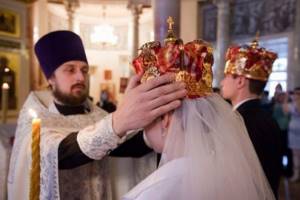
Next comes the Sacrament of the wedding itself: the priest puts crowns on those getting married, which is why the Sacrament is called a wedding. By the way, this also did not come immediately, but in the 4th century it already took shape, because St. John Chrysostom already writes about crowns. What kind of crowns are these? The Holy Fathers said this: this is a crown, on the one hand, of martyrdom. And people receive crowns for some kind of feat, a martyr is crowned for fidelity, steadfastness in the confession of Christ. And the spouses get married as people who have remained faithful to each other, their virginity, chastity until married life. But the crowns also have the meaning of royal crowns: it is as if a new kingdom is being created - a family where there is its own king and its own queen, and before these people lived in the house of their parents, where they were not the owners - now a new stage of their life begins. The king and queen will have subjects - children. And it was not without reason that Metropolitan Anthony of Sourozh reminded that in ancient times those getting married were called “prince and princess.” So these crowns are a symbol of their power, the crowning of a new kingdom.
What follows is a very important reading from the Apostle - the Epistle to the Ephesians of the Apostle Paul about what the responsibilities of a husband and wife are towards each other. Here the depth of the wedding is revealed. After all, an Orthodox wedding is an image of the combination of Christ and the Church. How Christ is the head, “the savior of the body,” as the Apostle Paul says, that is, of His Church, and the bride of Christ is the Church, and the Lord is ready to lay down His soul for the Church, which He did, making the great Sacrifice for us all on the Cross ; in the same way, the husband is ready to sacrifice for his wife the most important, most precious thing in life, if necessary. “Before the husband is the head of the wives, just as Christ is the head of the Church, and she is the savior of the body, but just as the Church obeys Christ, so also do the wives obey their husband in everything. Husbands, love your wives, just as Christ loved the Church and gave her to Himself for her sake” (Eph. 5:23–25). It says here how the Church must obey Christ and how Christ must take care of the Church and be the head of the Church. And the husband, as the head of the church - the family, this small church community, is compared to Christ. The family has such a name - “small Church”, “home Church”.
Why is the family a small Church? We know that the Lord creates the human race as a family - first as the family of Adam and Eve, then as the Church of God. And even a monastery is an image of a family, where people call each other “brothers in Christ” or “sisters in Christ” under the leadership of a single father, for example, an abbot. Because a person is not saved alone - a person is saved in a community. By interacting with each other, serving each other, we are saved. And the most important task of creating a family is precisely the salvation of its members: together we move towards salvation. It is not for nothing that during the Sacrament of Wedding we look in the very right direction - to the east, and the spouses do not stand facing each other, but turn to each other only when they congratulate each other, kiss each other at the end of the Sacrament of Wedding... But they look, standing next to each other, holding in their hands there are lit candles, just in the eastern direction - that is, they are going to Christ together. As Antoine de Saint-Exupéry said: lovers are not those who look at each other, but those who look in the same direction. For us, this side is the most important - the eastern one.
One can also say this about husband and wife in this small Church: the husband is the head, he is, as it were, a high priest; the wife is compared to a deacon - this is the second degree of the priesthood - a minister; the word “deacon” is translated like this: a servant, a minister in the performance of the sacraments. And their children - “all the children whom God gave me” - are parishioners of the small Church. The task of this family ship is salvation: “Where two or three are gathered in My name, there I am in the midst of them” (Matthew 18:20) - this is the most important thing for which we perform a wedding, for which we bless the marriage as a small Church.
By the way, some elements of the wedding are very similar to priestly ordination: the priest is led around the throne in the same way as spouses are led around the lectern, and the same chants are sung, only in a slightly different order. Just as a priest marries the Church, so the groom marries his bride.
Then it is said - and this is also a very important point - about the duties of a husband: “So husbands should love their wives as they love their own bodies: if you love your wife, you love yourself. No one ever hates his own flesh, but nourishes and warms it, just as the Lord does the Church” (Eph. 5: 28–29). That is, the bride, the future wife, is compared to the body of her husband. There is an expression: to love as yourself. Some believe that it is somehow fiery, some kind of special love. But this expression has a completely different meaning. Each of us wants to be respected, pitied, honored, cared for - this is what it means to “love as oneself.” No one wants to be reprimanded, nagged endlessly, treated unkindly, not fulfilling their duties... It’s all very simple: you don’t wish harm on yourself, and don’t do it to anyone else; If you wish yourself well, a good attitude towards yourself, do the same towards others.
But in this passage from the Epistle of the Apostle, read at the wedding, great love is also commanded: the husband is commanded to love his wife such as Christ’s love for the Church. What did Christ do for the Church? “He gave his life for her.” With what kind of love do we love ourselves? “We won’t harm ourselves.” But for the sake of our loved ones, we can do something to the detriment of ourselves. When a loved one, for example a child, gets sick, I think that any normal parent would not hesitate to give his kidney for him, if necessary; he will give up his second one, he will give up his life, he will sell the apartment so that the child can live, so that he will be healthy... And you love any person close and dear to you even to the detriment of yourself, that is, it turns out that you love him with even more love than you love yourself. This is the highest love that the Lord commanded us in the Sacrament of Marriage, and this is revealed very well in the Apostle we read.
Fear is a kind of trepidation, a reverent attitude. This is not a fear of some kind of punishment, despotism on the part of the husband - this is a fear of insulting, offending him
The last words from this Apostle: “But let the wife fear her husband” (Eph. 5:33). Usually some loud reader or deacon proclaims this to the whole church, and everyone immediately comes into awe, someone begins to smile, remembering some stories from life. What does it mean: “Let a wife fear her husband”? First, let us remember what the Apostle Paul said before: “Besides... let everyone love his own wife” (Eph. 5:33), that is, he loves as it was said, as Christ loves the Church. What does it mean “but the wife is afraid”, what does “afraid” mean? Like many Russian words, the word “afraid” has many meanings. We know, for example, the words of the psalmist David: “Work for the Lord with fear and rejoice in Him with trembling” (Ps. 2:11), that is, fear is just a kind of trembling, this is a reverent attitude. This is not the fear of some kind of punishment, despotism on the part of the husband - this is the fear of offending, offending a loved one, dear, close person. This is exactly the fear a wife should feel towards her husband.
Then the well-known Gospel is read about how the Lord was present at a marriage in Cana of Galilee and blessed this marriage, performing the first miracle there - turning water into wine. Metropolitan Anthony of Sourozh, interpreting this passage, says that in married life there may come a moment when people exhaust the resource of love, when their relationship begins to cool down - and then they need to especially ask God for help and intercession in order to replenish these empty vessels of their soul, their love with new wine, new grace of God, which the Lord naturally gives.
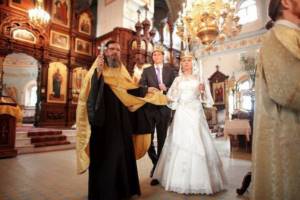
Then the spouses hang around the lectern - a symbol of eternity, infinity, joy. As at Baptism, a person is led around the font. After this, the crowns are removed after some time and the newlyweds are congratulated - this ends the Sacrament of Wedding.
***
The husband must take care of the spiritual education of his wife, must always be several steps ahead of his wife.
A few words about the spiritual life of the family. Spiritual life in the family, in fact, stems from the Sacrament of Wedding. A family is a small Church, as I already said, and spouses must not only solve the problems of raising children, some economic problems, and so on. The main task of the spouses is salvation. To be together not only here, but to be together in eternity. Together with each other and with their children. And, as St. John Chrysostom reminded, the task and responsibility of the husband is to take care not only of the spiritual education of his children, but also of the spiritual education of his wife, that is, the husband must always be, as it were, several steps ahead of his wife - not the wife should pull him first to the Sacrament of Wedding, then to First Communion, etc., and the spouse must go at the head, ahead of this small church ship. And may the Lord help you all in this very difficult, but very blessed, very saving, very happy family voyage! God bless everyone and the Mother of God!
Process steps
The sacrament is performed sequentially and consists of several stages that smoothly replace each other.
Engagement
It begins when the Divine Liturgy ends. The groom needs to stand on the right hand of the priest, the bride on the left.
The beginning of the ritual is censing. The priest blesses the newlyweds three times in turn. The young people are baptized, and the clergyman hands them burning candles.
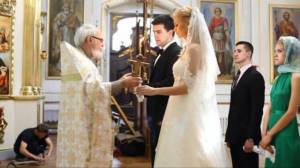
The rings are pre-blessed on the holy altar of the given church. The newlyweds exchange rings three times, and the priest reads a prayer for the Lord’s blessing and betrothal of this couple.
You can get engaged in advance. This is usually done a month before the wedding. Some couples believe that in this case a real sacrament is performed, because no strangers are present at the ceremony. In addition, the total time of the ceremony is subsequently significantly reduced. This may be important if there are many children and elderly people among the guests.
Marriage vows
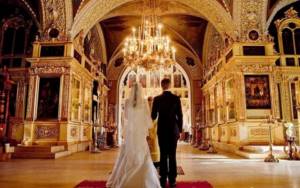
The priest asks whether the young people are voluntarily getting married, and whether they are misleading each other about their intentions.
Wedding
Three prayers are sounded, asking for a blessing for the newlyweds.
Then comes the most solemn moment - the priest, taking the crown, blesses the groom, then the bride with the words “Lord our God, crown them with glory and honor.”
Reading of the Holy Scriptures and the Common Cup
An excerpt from the letter of the Apostle Paul is read, which talks about the responsibilities of spouses in the family. Then the Gospel is read, and the prayer for the newlyweds is offered again.
Then everyone reads the “Our Father” prayer. It's better to learn it in advance. The newlyweds in it testify to their readiness to serve the Lord and fulfill His will in the family.
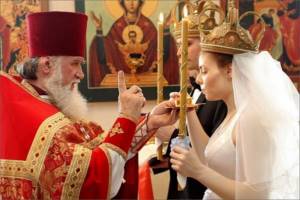
Walking around the lectern
The priest clasps the couple's right hands and covers them with the end of the epitrachelion (long ribbon) to represent the wife being given over to her husband.
Then he, holding a cross, circles the couple three times around the lectern. The circle is a symbol of the indissolubility of the concluded union. At this time, church troparia are sung, which give thanks for the marriage.
Then the crowns are removed from the spouses. They bow their heads and seal the union with a chaste kiss.
Orthodox prohibitions in the church
The church charter is full of strict rules regarding the conduct of sacred sacraments. So, during a wedding there are several prohibitions:
- wedding dresses cannot be given, sold or given for temporary use;
- the bride is forbidden to be in the temple with her head uncovered;
- hairstyles should not be too complex or high;
- if the wedding dress is complemented by a veil, then it must cover the top of the head;
- Do not apply too much makeup or use lipstick;
- the groom should not wear any hats;
- It is strictly forbidden for unbaptized people to take part in the sacrament.
A wedding ceremony is an exciting and important ritual. It is not for nothing that several days are given to prepare for it, so that the newlyweds have time to realize the importance of the upcoming event.
If you find an error, please select a piece of text and press Ctrl+Enter.
Preparation for the wedding
It is necessary to enter into a sacred union with a pure soul, and therefore, on the eve of the ceremony, you need to undergo serious preparation.
Selection of guarantors
Most often, relatives or friends of the newlyweds become guarantors. However, the church has several requirements for witnesses. So, they should not be in a marital relationship (official or civil), nor should they be divorced. If there are none, the sacrament can be performed without them.
Fast
Three days before the ceremony, the newlyweds must undergo a strict fast. It is prohibited to consume animal products and alcoholic beverages. You cannot smoke, use foul language, or have intimate relations. Instead of entertainment, it is better to spend time together reading prayers.
Confession
The day before the wedding, the newlyweds need to confess in order to cleanse their souls before the Almighty. Having repented of their sins, spouses find inner peace and are renewed spiritually so that the marriage union can be filled with God's grace. It is also worth remembering that the priest is just an intermediary between God, and therefore you should not be afraid of him.
Participle
Before the sacred ceremony itself, young people should take communion. The Eucharist is celebrated at the morning liturgy, when the newlyweds are given the Holy Gifts from the hands of the clergyman. At the same time, it is not recommended to eat, drink, drink alcohol or smoke in the evening.

Fast
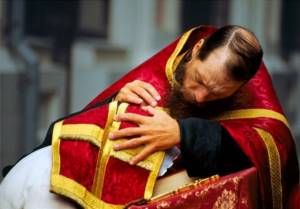
Confession
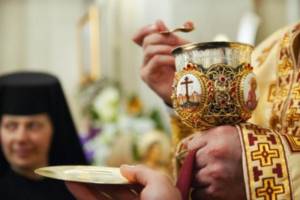
Participle
